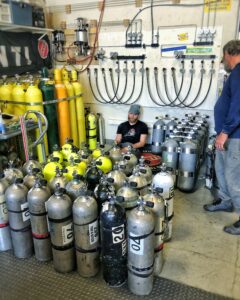Aleutian Dive Expedition 2021
A NOTE ABOUT THIS TEXT:
The following is a collection of posts made on social media regarding our 2021 dive expedition to the wreck of the SS Aleutian. It is somewhat disjointed, because these were published in chronological order over the series of multiple weeks in September 2021. If you would like to see the posts in context, along with the relevant videos and images associated with them, please feel free to check out our Instagram or Facebook pages, and go back to that time frame.
This reads much cleaner, and definitely makes more sense..
But we can’t tell you what to do.
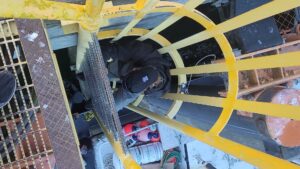 Having a practical reason to climb up and down one of these ladders while loading/unloading a dive boat makes you feel like the coolest person in the world.
Having a practical reason to climb up and down one of these ladders while loading/unloading a dive boat makes you feel like the coolest person in the world.
B the cool u want 2 c in the ?.
And let’s go diving!
Also, BREAKING MOO’S ???
Aleutian Update Week starts on Sunday. It’ll definitely be underwhelming, but we’re going to start the narrative account of our recent expedition to the SS Aleutian. At least, one perspective on it.
Get hype.
BREAKING: This is the start of Aleutian Narrative Week (or Weeks).
We may take a break, but we’re going to start detailing some aspects of our recent expedition out to the SS Aleutian, outside of Kodiak.
We’re scheduling this post on the 6th, so we’re basically backing ourselves into a corner with the deadline and forcing ourselves to push out info, but we didn’t want to wait too long, and we’ve edited most (well, maybe a quarter) of our content.
Starting off on a light, and somewhat embarrassing note (and not really contributing to the narrative account)….
Vol. 1: Sunday Sity Slicker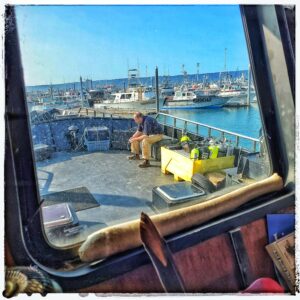
The guy who took this photo is from Los Angeles, and when he first sent it to the gentleman in the photo, he learned what an oosik was.
He had previously not been exposed to that term, or exposed to the fact one was present in this photo. He thought it was just a neat, artsy photo of his dive buddy working on some knots.
It was knot.
If you don’t know what it is, Google “oosik.”
Crossing the Gulf, the Art of Levitation, and How Much Vomit Can You Hold In Your Hands?
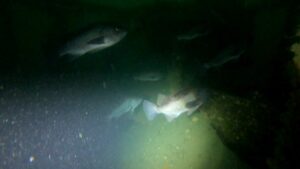 While a lot of folks definitely saw us loading the ???-?? in Homer for our trip across the Gulf of Alaska to the ?? ????????, which lays outside of Kodiak, what most folks didn’t hear about was the actual crossing itself.
While a lot of folks definitely saw us loading the ???-?? in Homer for our trip across the Gulf of Alaska to the ?? ????????, which lays outside of Kodiak, what most folks didn’t hear about was the actual crossing itself.
?. Weather in Alaska is unpredictable, and when planning a trip like this, the flexibility and zen of “What happens, happens” is critical for keeping sane and upbeat.
The weather beat us to pieces on the ride over, and it ended up chasing us off the wreck prematurely. But what can you do?
(???????. ??? ?????? ?? “???????.”)
?. Good Lord, we can not understate how brutal crossing the Gulf was. 13 foot seas for 30 hours, non-stop. Everyone in the forward cabins was experiencing free fall as the bow cleared each wave. Everyone midship was lounged in abject misery, experimenting with different drugs, incantations, and spells in a futile effort to mitigate their suffering. The author of this post vomited into his hands on the way to the garbage can.
Contrarily, we made the return voyage in about 12 hours and it was flat calm.
It’s the nature of diving up here, which isn’t exactly the best diving environment for anyone who clings to “best laid plans.” We were starkly reminded of this immediately and reminded throughout the trip.
Very Serious Divers Posing for Very, Very Serious Team Photo
The distinguished roster is as follows:
- Steve Lloyd (explorer, historian, author, discovered the Aleutian, diver, and advisor)
- Brandon Hunter (organizer, fill station operator, diver)
- Jeremy Lily (emergency protocols, diver, calming presence)
- Ron Fancher (present)
- Orie J Braun (photogrammetry, team logistics, simultaneously man and oreo, equipment contingencies, diver)
- Marc Connelly (team surgeon, medical advisor, decompression contingencies, diver)
- Alex Fancher (spirit animal, diver)
Everyone pitched invaluably, and the sum of the whole was infinitely greater than the sum of the individual parts.
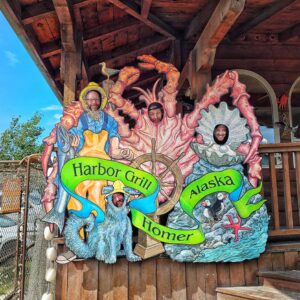
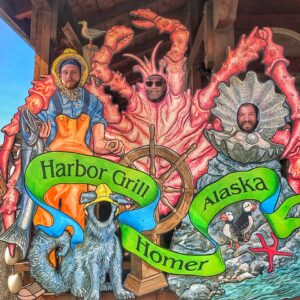
Vol. 2: Wes Anderson Vibes and Logistical Puk-Uk’s
So, there’s planning and preparation, and then there’s over-planning and over-preparing. Aleutian 2021 was a great example of both of those.
When it came to hardware and logistics, we definitely felt that we had over-planned, but we ended up needing almost every last adaptor, fitting, wrench, and bracket.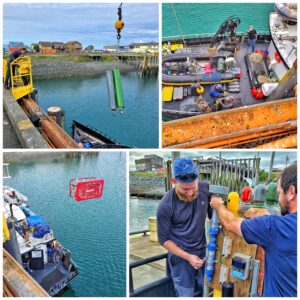
The challenge of setting up a busy trimix fill station on the back of a boat that was not designed to have a busy trimix fill station on it meant that we needed everything we thought we probably wouldn’t.
On the flip-side, we planned for much more significant dive gear issues than actually took place. Everybody brought some save-a-dive kit, and then there was a “team” save-a-dive kit that included entire replacements of almost every component of dive-specific gear. Outside of common issues you would have with an open water class, none of this stuff got touched, but we sure hauled it from Anchorage, to Homer, across the Gulf of Alaska, and allll the way back.
Now, with all that planning, we still missed preparing some very little, but ultimately, very crucial aspects of the trip.
A couple quick examples:
- I (Ron) never tested the light and camera rig that I had anticipated using for my DPV. That meant when I went to mount my GoPro to the scooter, for whatever reason, none of the holes on my case lined up with the mount on the scooter, despite them coming from the same box. That meant that I had to zip-tie the camera to the nose zinc with dry gloves on, and got iffy footage at best.
- Nobody really checked the depth ratings on their camera housings. Most using GoPros dealt with stuck buttons and fog/condensation inside our housings that crippled a lot of potential video and photo opportunities. A handful of moisture packets and an appropriate housing (like the Isotta housing I ordered the day I got home) would have gone miles.
- And while the depth rating and stick buttons things definitely wasn’t common (we’ve all used our cameras below 200 feet before) the condensation on deep/cold dives was 100% a known factor, and a $10, 10 pack of moisture munchers could have prevented it.
All of this isn’t world-ending, trip-ending, or even dive-ending. But it was definitely inconvenient, and enough inconveniences always have the potential to cause a serious problem.
That said, it was all excellent learning, and we definitely took away a number of lessons, tools, tips, and tricks that will be invaluable in the future. It’s the whole cliche of “you don’t learn in comfort, you learn in ??????????.”
“The diving is the easy part of all this. Everything else is the challenge.”
–Brandon Hunter, ft. #manoreo1
 This was the deck crane we used to lift equipment off of the dive tender. Basically, the procession of equipment would go:
This was the deck crane we used to lift equipment off of the dive tender. Basically, the procession of equipment would go:
- Gear up on the deck of the Puk-Uk, and either step off near the down-line, or get towed by the tender to it.
- After diving, the tender would pick divers up, they would shed their kit in the water, and then haul it over the side of the tender.
- Tender returns teams to the Puk-Uk.
- Once all the teams were out of the water, we would use the deck crane to haul gear onto the deck for fills.
- Rinse (metaphorically) and repeat.
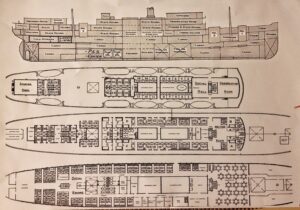
Deck Plans (and We’re Not Talking Patios)
These were the deck plans of the SS Aleutian, supplied by Steve Lloyd and Brandon Hunter.
If they look a little confusing to the untrained eye… there were a handful on untrained eyes on trained divers on the boat, and after a week of diving, they’re starting to make sense to some of us.
Some of the divers picked up quickly. Some did not. When visibility is four feet and there’s not a ton of ambient light, it takes a strong and concise imagination.
If you’ve met some of us, that applies to some more than others.
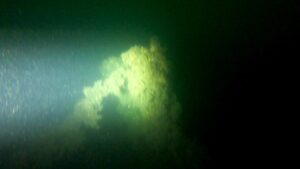
Bow Down, Anchor Up, and Lining Out the Diving
We’ll talk about it later, but the visibility on the Aleutian is uniquely terrible. However, because the wreck is sitting perfectly upright, almost like it’s in dry dock, it’s very easy to navigate.
Initially, we had planned on laying line to help us orient to the ship. However, because it’s upright and intact, this would end up being time we didn’t need to spend (excepting penetration). On the first dive, we didn’t make it very far, because we were a little over-concerned with orientation, but it wasn’t until after a couple dives that we realized our fears were (mostly) unfounded.
On one of our first dives, we descended down the anchor line, and took an immediate right to the bow of the ship. One neat point of interest were the very front of the ship, which was covered in a thick line of plumose anemone from the top of the deck, extending down to the sea floor (and providing a great reference when scootering around the outside of the ship).
Another cool feature was this huge deck anchor, still resting in its cradle almost a 100 years after a submerged pinnacle ripped a fatal hole in the Aleutian. When you’re swimming up the bow, it’s almost directly in the middle of the deck on the forewardmost section.
The video here is slowed down, because we weren’t 100% sure what we were looking at until after we took it.
Like we said, viz wasn’t exactly great.
Fill Station Frenzy.
The logistics of building a trimix station on the back of a salmon tender are a ton of fun and interesting challenges, especially when money is *definitely* an issue. You can pour cash on a problem when funds are unlimited, but when they’re not, ya gotta get creative.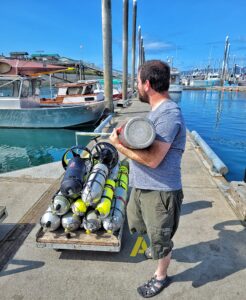
Let us be the first ones to tell you… we are incredibly creative.
Personable? Eh.
Funny? Eh.
Professional? Ehhhh.
Likeable? Ehhhhhhh.
Creative? Yep.
This was a unique, interesting challenges, tackled by the humans on this boat, with a metaphorical and literal boatload of combined resources, experience, and expertise. True mutual collaboration where every individual is invaluable to the group.
Hopefully will have some cool stuff to share when we get back. Love all of you. Go diving and send us photos!
We Have a Very S3rious Point 2 Make:
Sometime in the next couple weeks, we’re going to be sharing a pseudo-narrative account of our trip to the SS Aleutian, along with a bunch of new content from the trip.
However, we’re not a single-minded diving enterprise, and while a couple of our staff were doing that, a bunch of other were doing awesome diving in SC AK.
 Local diving, spearfishing, freediving, teaching entry-level classes in scoob and freedive, exploring alpine lakes, digging around for stories of sunken wrecks, repairing drysuits, building hydro stations, improving fill stations, servicing equipment, playing with pitbulls, and more. Literally, everything and anything.
Local diving, spearfishing, freediving, teaching entry-level classes in scoob and freedive, exploring alpine lakes, digging around for stories of sunken wrecks, repairing drysuits, building hydro stations, improving fill stations, servicing equipment, playing with pitbulls, and more. Literally, everything and anything.
All of that is stuff we love. All of that is equally valid and worth attention. So, we’re always going to give it the recognition it deserves; that’s why we’re here, after all.
Because our community is wonderfully and insanely diverse, and we will never, ever emphasize one aspect of it over another (or, to the neglect of an other aspect of said diversity), the way we share some of that may come across as slightly scattered, because we’re actively trying not to overemphasize one specific trip/discipline/aspect/agency/etc.
If it comes across as neurotic, that would make sense, because so are we. Buncha neurotic humans sharing a passion for water, work, exploration, and generally having a helluva time doing all of it.
That’s whatcha get.
We love you all, and let’s go diving!
Footage Faux Pas and Why We Don’t Have More Fotos
So, you’ll notice that we never really got any phenomenal footage of the Aleutian. That’s a mix of a number of factors…
?) It’s very deep, and there’s no ambient light to speak of. None.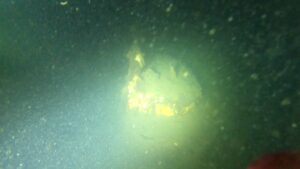
?) The aforementioned camera issues, both with housings not suited to the task, as well as fogging from the cold.
?) Coordination. With the exception of one or two shots (specifically, the shots of the mast) we never really had videography as a primary goal, and very rarely deployed video lights.
But most importantly….
?) It is an ?????????? silty wreck. Like, insanely so. Steve Lloyd describes it as “the siltiest wreck he has ever dove on” and let us tell you, that man has dove ? ??? of shipwrecks.
This is because of The Great Eruption of 1912, courtesy of the volcano Novarupta.
If it sounds benign, it’s not. It was the largest volcanic eruption of the 20th century, and the largest-ever in North America. It was responsible for creating Katmai National Park and the Valley of Ten Thousand Smokes, and the eruption was heard in Juneau.
 It spewed so much ash out, that over 100 years later, wind can still kick up enough ash from the eruption to garner FAA advisory warnings in the area. It was 30x larger than Mt. Saint Helens.
It spewed so much ash out, that over 100 years later, wind can still kick up enough ash from the eruption to garner FAA advisory warnings in the area. It was 30x larger than Mt. Saint Helens.
And it erupted only miles from where the Aleutian rests. While it’s pure speculation from others smarter than us, it would not be surprising to find that the bottom composition of the sea floor in the area has literal tons of volcanic ash mixed in. From a divers perspective, everything on and around the wreck resembled and behaved like the glacial silt we find in local freshwater lakes.
Which is about as pleasant as it sounds, in regards to visibility.
In this video, port side: above deck, a sink, and a porthole, in that order. (Video can be found on our Youtube page).
In this post is a rendering of the size of the previously mentioned ash cloud, courtesy of a NPS article on the Novarupta event. This took place mere miles from where the ?? ???????? settled on the sea floor. If this doesn’t show you how much ash was thrown into the air (and by extension, into the water and land), the only thing that will change your mind is diving the ???????? itself.
Flying Full Mast
The mast of the SS Aleutian is the most note-worthy and striking feature on the wreck. Almost 80 feet tall, and glowing white from the forest of plumose anemone carpeting it, it’s an ethereal sight.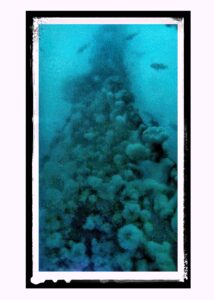
We have some super neat video of the mast. We’ve already shared some, and will share more soon. You know what we don’t have that’s sweet though?
Any decent photos of the freaking thing.
This isn’t a great photo. We tried to dress it up by over-editing and throwing a frame on it, but you can only do so much. This photo is an example of why we didn’t take more photos.
Low light, tons of sediment, generally fairly task-loaded, etc does not make for great photos. It would be a task for an exceptional photographer, and at least for the people running this specific account, we aren’t even competent photographers, let alone exceptional.
Better video to come within the week. You could also check out our YouTube page if you’re impatient.
Let’s Stare Motionless Into the Void for 60 Minutes and Call It “Fun”
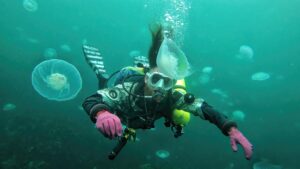
Most of the dives on our trip involved anywhere from 30-90 minutes of deco, with the original plan being two dives a day with 60-odd minutes of deco each. At least half of that is spent at a 20 ft. stop on oxygen.
We commonly hear “What do you do to kill all that empty time?”
Some people like taking photos. Some people read books they bring in their pockets in baggies (and keep them saturated). Some people play rock, paper, scissors or tic-tac-toe.
If a dive had something noteworthy, or if you were surveying, it’s a good time to whip out wetnotes and start refining data, sketching, fleshing out notes, etc.
But in all honesty, staring at nothing for 30 minutes to an hour is incredibly cathartic. You can nap, close your eyes, or just be still and hold your stop. Once you settle down and quiet your mind, the time passes incredibly quickly, and it’s not so much “empty time” as it is a medititative practice of awareness and release.
*Especially* for those too neurotic to meditate on land.
Lion’s Mane-ia, and Good Lord, Does My Face Sting
Because we primarily ascended and descended on the same line, and because the teams diving were staggered, the second team descending would pass the first team while they were in the middle of deco.
 One of the things we did not envision happening was the Bubbly Sting Jellies.
One of the things we did not envision happening was the Bubbly Sting Jellies.
We may have (or may have not) just made that up, but basically, what would happen to the first team is that they would begin their dive on the down-line, complete their dive, and return up the line, typically switching onto deco and clearing their first couple stops.
Right around then (typically between 70-40 feet) the second team would hit the water and pass them on descent. Almost immediately, the bubbles from the descending team would start blowing up some of the largest lion’s mane jellyfish we had ever seen.
(?? ??? ???’? ???? ????’? ????, ????’?? ? ???? ?????? ?????????, ???? ???????? ???? ????????? ???? ???? ????? ????? ??? ????-?????? ???????? ??? ?? ??? ???? ??????????.)
After a couple minutes of descent, the second team would clear the line, and the jellyfish brigade would slow down.
However, because of the extreme depth, our bottom times were never longer than half and hour. And because we were doing around an hour of deco, that meant the second team would return to the up-line and resume blasting the team above them straight in the face with more bubbly lion’s manes while they were finishing deco.
Just one giant, terrible, ascending tumbleweed after another.
What’s interesting is that there were almost no jellyfish on the wreck, but they were attracted to our up-line like the worldest most annoying bug zapper. If you were the first team in the water, you were guaranteed to get onto the boat with your face burning around the line your mask forms with your hood.
Sweet Saturday Scuba Spaghetti
However much rope you think you may need for a deep, remote, tech diving expedition you think you may need…. bring more.
Like, at a minimum, four times more than you think you could ever possibly need.
Basically, a good rule of thumb is to hypothetically plan on trying to hang all of the following animals, by their individual appendages, from any given overpass, measure off that quantity and thickness of individual lengths of rope, and bring those sections of rope/line with you. Alphabetically:
- An ant (six legs)
- A bobcat (four legs)
- An elephant (one trunk, four legs)
- A gerbil (four legs)
- An octopus (eight tentacles/sea legs)
- A zebra (four hooves)
Then, you won’t need to crawl through the dumpsters in a harbor town in Alaska looking for bits of rope to do literally everything you could possibly think would or wouldn’t need rope for.
Peaked Too Early 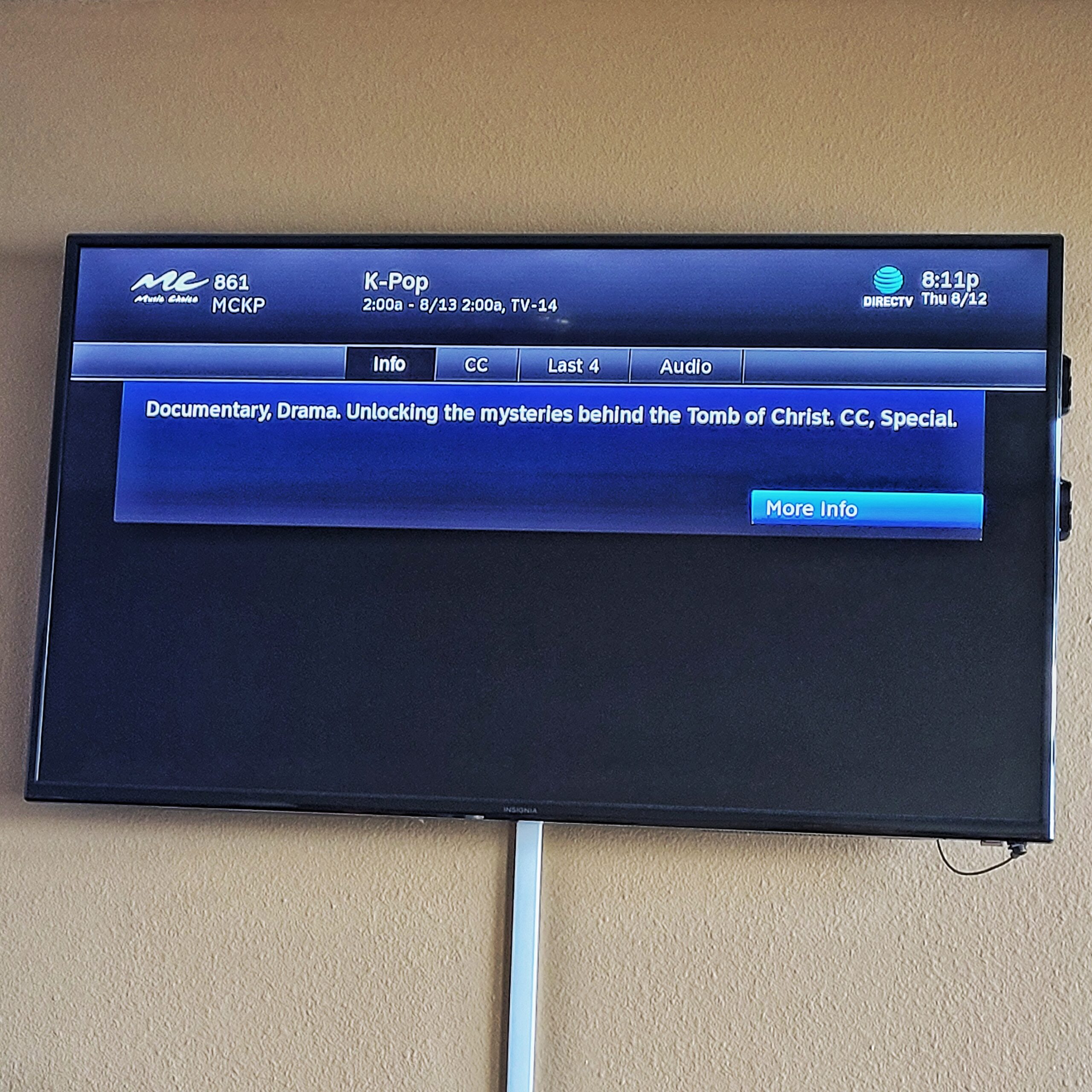
Perhaps the most remarkable thing about the entire Aleutian expedition was this whirlwind of a channel/show description at the hotel the day before we left.
We thought we knew what K-Pop was.
Turns out, we were wrong.
Absolutely incredible.
Trimix station in the back, oxygen and helium on the sides, fill whips and tanks in the bow, and the party 200 ft. down over the side.
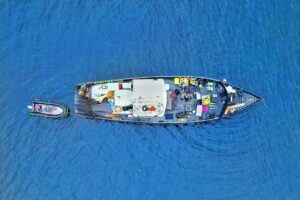 Sometimes, the logistics of planning and exciting a dive are every bit as rewarding, and maybe even *more* challenging, than the diving itself. It’s one of the things that makes diving up here so much fun.
Sometimes, the logistics of planning and exciting a dive are every bit as rewarding, and maybe even *more* challenging, than the diving itself. It’s one of the things that makes diving up here so much fun.
Get u sum expedition diving.
Let’s. Go. Diving.
Also, a lil’ teaser for later today, we have a deck-level, 57 second walkthrough of what filling tanks for seven, Tech 2, hypoxic trimix divers looks like.
Hello Ocean, We Sea U.
I know this video was taking when we were going home, but that doesn’t mean we won’t see you again soon.
We should go diving sometime.
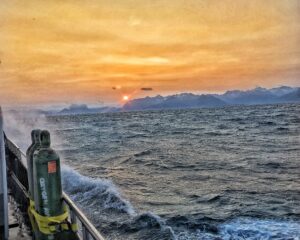
Take a Joke (And Maybe a Seal Bomb)
It’s remarkable how much a seal bomb resembles a totally fun nighttime prank that will get you beaten with pipes and duct-taped to your bunk…
The counter-point would be that if you didn’t want a seal bomb thrown in your sleeping bag, you wouldn’t leave them where anyone could find them.
Some quick snippets from when we were still in cell service.
Let’s go diving.
And hide the seal bombs.
Big Air.
 Get it?
Get it?
Air?
Gas?
Scuba puns?
Regardless of how stupid the jokes are, ya gotta admit, it’s pretty cool when your dive trip involves an industrial crane hoisting two compressors and 26 helium and oxygen bottles onto the deck of a 71-foot long expedition boat.
A couple quick snippets from when we were still loading up in Homer for a lil ‘xplorin. Let’s go diving.
City of Industr(ial Welding Cylinders)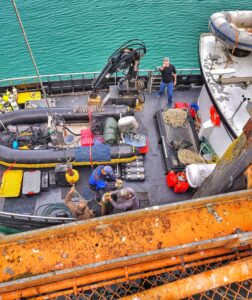
You know that you *might* be in for a good time when the statement “Let’s load the dive boat” involves 14 bulk bottles of helium, 11 oxygen, two compressors, two boosters, and an industrial crane.
Oh, and then all of your gear for actually diving, cameras, batteries, DPV’s, tarps, whiteboards, and more. Five full pickup trucks, five hours of driving, and 18 hours at sea to get to the dive site.
Fun things are a-float.
LET’S. GO.
Vol 3: First-Time Visitors and Old Friends
How often do you get a chance to dive a historic shipwreck with the diver who discovered it? One of the coolest things about diving the ?? ???????? was that Steve Lloyd, the gentleman who discovered the wreck in 2002 (and a fantastic dive buddy and historical resource) was a team member.
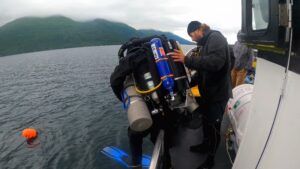 Here, him and Jeremy Lily splash with their CCR’s to secure what would be our up-line for the week–the man who discovered the wreck and a diver descending on it for the first time. Because there were multiple teams in the water, the wreck itself is substantially large, and we only had one tending boat, returning to the up-line was factored into every dive plan.
Here, him and Jeremy Lily splash with their CCR’s to secure what would be our up-line for the week–the man who discovered the wreck and a diver descending on it for the first time. Because there were multiple teams in the water, the wreck itself is substantially large, and we only had one tending boat, returning to the up-line was factored into every dive plan.
Failing to do so could potentially tax boat resources, and by extension, compromise safety. It wasn’t imperative, merely best practice. The up-line was our return point on every dive (whether or not we made it there…).
Tangentially related; while the rebreathers Jeremy and Steve are wearing allow for a greatly extended gas supply and bottom time, they do nothing to shorten decompression obligations. Which means that open circuit or CCR, everyone did the same amount of deco.
Sunday Ship Snippet (aka Shippets)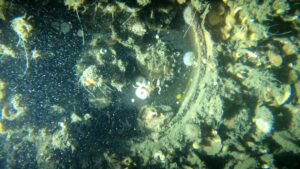
Because the Aleutian is effectively sitting like an artificial reef, in the middle of giant, deep mud flat, it is absolutely teeming with some of the largest rockfish we have ever seen.
Interestingly, there wasn’t much invertebrate life, and outside of plumose anemone, there wasn’t much in the way of decoration.
But the rockfish… holy smokes. The rockfish had a vibe that they were just ?????????? us on ????? wreck. It was frankly a little unsettling.
In the rest of this clip, you can see life boat davits, deck structure, the passenger causeway, and some entry/exit windows.
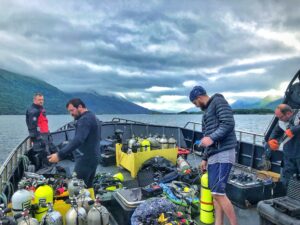
Monday Fill Station Fantasia
Not unlike how we spend our Monday’s at the shop filling tanks non-stop, here’s a walk-through of the fill station from the Puk-Uk in action.
If you ever wanted to pretend you’re filling a seemingly endless supply of hypoxic trimix, deco gasses, and more, all while suffering potential long-term hearing loss, then boy-howdy, do we have the video for you!
(If you’re reading this on our website, check out our YouTube channel!)
At times, it was wee bit hectic, and it was also just way too loud, but such is the price of remote, deep, scoobin.
No, No, not “Crack-Pot”… “Crab Pot.“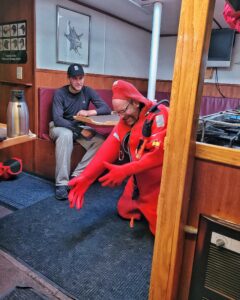
Historic wrecks in Alaska are offered a pretty serious blanket of protection by the state.
Keeping this in mind, even when we were installing our up/down line, we were taking care to leave no marks of every having been there.
As the old saying goes…
Take only photos, leave only bubbles, and holy s***, these are some very heavy doubles.
All that to say, even our primary line to the wreck didn’t actually touch the wreck, but was secured to a crab pot that adjacent to the bow.
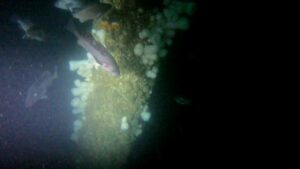 Stacks on Stacks: Exploration or Just Discovering Narcosis?
Stacks on Stacks: Exploration or Just Discovering Narcosis?
These were a couple shakey clips from the fallen object on the starboard side of the Aleutian.
Obviously, the video isn’t exactly “conclusive evidence” for anything, but it was interesting as it was the only clearly defined object on the perimeter of the ship (besides the screws) and did match the shape and description.
It will definitely be one of the first things that will get documented, photographed, and recorded in better detail on future expeditions.
Saturday Spirit Animal
Every expedition needs a spirit animal. We got Alex.
That counts for something.
Maybe.
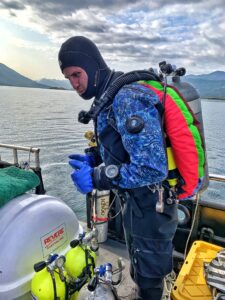
Monday Mornings Feeling Like…
Because we were racing like mad divers, trying to beat a legitimate gale on our return trip from the Aleutian, it made for an incredibly early morning on our last day, and resulted in a handful of unsaid goodbyes.
That said, nobody wanted a 30 hour, 13 foot seas, hell-crossing both directions. One was good enough.
If there are any questions or thoughts that you’d like to know about the trip, let us know, and we’ll do our best to answer, or make a specific post addressing it!
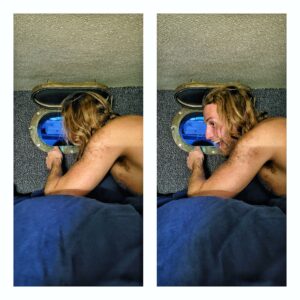
Aleutian 2021 Debrief and Clean-Up: A Picture Tells a Thousand Words
If there are any questions or thoughts that you’d like to know about the trip, let us know, and we’ll do our best to answer, or make a specific post addressing it!
